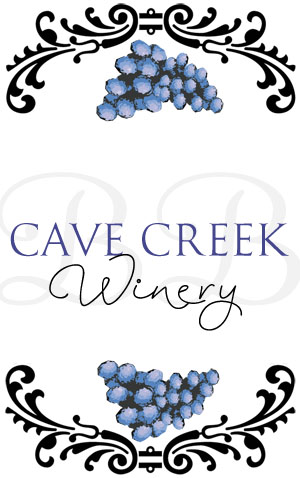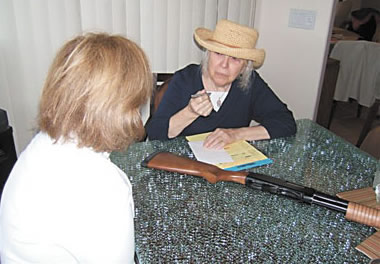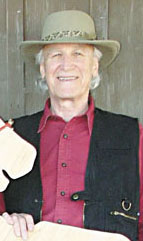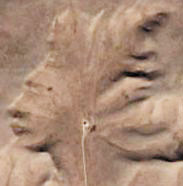
Cave Creek gets the blues
By Shari Jo Sorchych | April 1, 2010
 Winery locates in the
Desert Foothills
Winery locates in the
Desert Foothills
CAVE CREEK – The Cave Creek Winery is scheduled to open to the public for wine tastings and retail sales on Friday, April 30!
The greatest challenge has been keeping the establishment a secret for two years until the first batch of wine was ready. Hidden away in north rural Cave Creek behind a tall gated wall, it was less difficult than it would have been if the winery had been in a more visible location.
The owners have taken a totally new approach to making their wines by using blueberries instead of grapes. Because blueberries are sweet like grapes, the wines are surprisingly tasty, but healthier than the grape varieties. The fermentation process is much the same and takes about the same length of time as a traditional grape wine.
The colors of the various wines range from a deep blue to almost purple. Blends immediately available from Cave Creek Winery include BB Razz, BB Kiwi and BB Lime.
Tastings will be a departure from what is commonly offered. Dinner tastings will be available every evening except for Monday. Reservations are recommended, but you are welcome to call after 4:30 p.m. to inquire about the 8 p.m. dinner seating.
Happy hour tastings will be every day except Monday from 5 – 7:30 p.m.
Food for both happy hours and dinners is prepared in the fabulous Cave Creek Winery kitchen under the supervision of Head Chef August Bremer. His most recent prior engagement was as Head Chef with the Old World German Restaurant in San Antonio.
Bremer prides himself in offering exactly what his customers request. Tasters will find new appetizers and dinners offered each time they visit. Your ‘tasting’ experience will never be repeated exactly.
Weekends at Cave Creek Winery offer even more fun! Saturday and Sunday morning brunches offer flights with a special culinary creation for each weekend.
Reservations ongoing and begin Friday, April 30.
We officially welcome the Cave Creek Winery!
Famous older mother receives medical degree
By Steele Coddington | April 1, 2010
 April Smothers, right, made headlines two years ago when at age 87 she had a baby girl. Now a doctor, April counsels a patient on how to respond to an abusive husband.
April Smothers, right, made headlines two years ago when at age 87 she had a baby girl. Now a doctor, April counsels a patient on how to respond to an abusive husband.
KRISHNANAGAR, India – It’s been a horrendous two years for April Smothers, 89 year old mother of daughter Pocahantas, born two years ago on the Navajo Reservation in northern Arizona. Mrs. Smothers has attempted to legally establish Navajo citizenship for her daughter since she was delivered on the reservation, using the “anchor baby” theory applied to all children born in the U.S.
However, the argument was not affirmed by the local Superior Court and she appealed to the 9th Circuit Court of Appeals through her Navajo attorney Charlie Horse Feathers. As Mrs. Smothers explains, “That damn liberal bunch of Clinton and Obama appointees turned us down. So we took the only other legal course open.”
She took her baby and went to India where she will establish duel American and Indian citizenship for Pocahontas after the residency requirements are met. Then she will begin the difficult but unique legal battle proving that American Indians are remote ancestors of the people of India. This will establish the legitimacy of Pocahontas as an Indian Indian and a true Navajo citizen, making her eligible to own a gambling casino on the reservation.
While living in Krishnanagar, Mrs. Smothers enrolled in the University of India Medical College and completed her Doctoral Degree program in Ancient Medicines of Hindu Culture and the Bhagavad Gita, earning the international Ancient Mere Medicionale Degree (AMMD) awarded to mothers over 80 years of age. She has been practicing in Krishnanagar, about 100 miles north of Calcutta, while pre-school home-schooling her daughter Pocahontas.
Dr. Smothers’ practice emphasizes Ghandian principles with Gautama Buddha’s (563-485 BC) belief, “The mind is everything: what you think, you become.” Her practice includes Christians, Buddhists and Hindus employed by the American State Department and U.S. telephone answering companies who need counseling in stress, confusion and conflict brought on by the many cultures in which they work. Dr. Smothers focuses on culture reconciliation integrating Ghandian principles of peace with American Second Amendment rights involving self protection.

North American fault movement indicates earthquake likely
By Shari Jo Sorchych | April 1, 2010
Tectonic plates make up Earth's outer shell, called the lithosphere, which includes the crust and uppermost part of the mantle. Geological activity – movement of the plates – is caused by churning molten rocks below.
The movement of the plates creates three types of tectonic boundaries: convergent, where plates move into one another; divergent, where plates move apart; and transform, where plates move sideways in relation to each other.
According to Don Aamero of the United States Geological Research Institute the Yellowstone hot spot is not related to a deeply fixed plume, but rather to upper-mantle convection related to the regional extension that pervades the northwestern United States.
The hot spot track at Yellowstone runs along what is known to be a major structural boundary in the lithosphere. The Eastern Snake River Plain records the former track of the Yellowstone hot spot, marking the northern edge of large-scale regional extension. There does not appear to be evidence for a deep mantle source.
Scientists have pinpointed a set of faults in the Midwest that cause severe earthquakes every 500 years. The quakes are so powerful that they can cause the Mississippi River to temporarily flow backwards.
The New Madrid Fault (pronounced MAD-rid, short as in "mad" and accent on first syllable) is located in Southeast Missouri. The town of New Madrid sits on a major fault that extends into Arkansas. In the early 1800s, a series of magnitude 8 earthquakes occurred.
Geologists suspect the New Madrid fault is a failed rift valley: a place where the North American continent almost split into two pieces.
What we know from history is that if something geologic has happened in the past, it can happen in the future. Earthquakes are not a matter of “if” they will happen, but “when” they will happen.
These mid-continent temblors have long fascinated seismologists because of the mysterious origin of earthquakes that occur not at the edges but in the center of tectonic plates such as the North American Plate that underlies the continent.
One recent study suggests that a mantle convective current is propelling the plate.
The fault map below shows the likely location of the rift should the plate movement intensify to the point of an earthquake along the Utah Lake Fault.
The water level (sea level) after the plate shift is difficult to predict. Boat owners along the new coasts are most likely to be unaffected by the resulting travel difficulties.
Creekers, never to run and hide, will need to prepare to shift from a rural desert community to a seaside vacation portal.


 Cordwell responded the Candy Store was considering either relocating or possibly opening another club.
Cordwell responded the Candy Store was considering either relocating or possibly opening another club. Last week, Sonoran News Publisher/ Editor Don Sorchych announced his plans to run for the Cave Creek Unified School District governing board, citing the current lack of fiscal responsibility as the driving factor. “Someone needs to show this administration how to tighten its belt during both good times and tough economic times,” said Sorchych, adding, “We just don’t have a limitless supply of other
Last week, Sonoran News Publisher/ Editor Don Sorchych announced his plans to run for the Cave Creek Unified School District governing board, citing the current lack of fiscal responsibility as the driving factor. “Someone needs to show this administration how to tighten its belt during both good times and tough economic times,” said Sorchych, adding, “We just don’t have a limitless supply of other  CAVE CREEK – Scientists from the Arizona Archaeological Society have confirmed that the massive head made of odoriferous granite recently unearthed on Black Mountain is, indeed, that of the famous Native American leader Pahrump (originally Pah-Rimpi, or "water walker") who lived briefly in this area before moving to the Spring Mountains in the area west of what is now known as Las Vegas, Nev. The town of Pahrump, Nev. is named in honor of Pahrump.
CAVE CREEK – Scientists from the Arizona Archaeological Society have confirmed that the massive head made of odoriferous granite recently unearthed on Black Mountain is, indeed, that of the famous Native American leader Pahrump (originally Pah-Rimpi, or "water walker") who lived briefly in this area before moving to the Spring Mountains in the area west of what is now known as Las Vegas, Nev. The town of Pahrump, Nev. is named in honor of Pahrump.